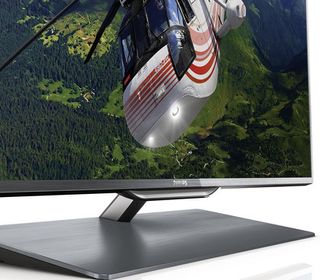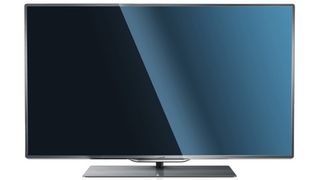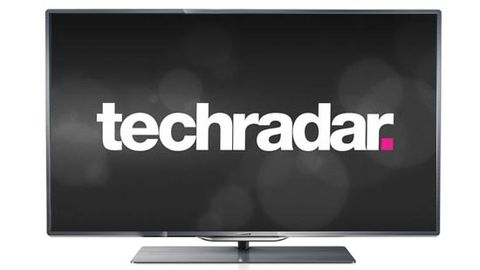Why you can trust TechRadar
The first thing to say here is that you need to be very careful with some of the Philips 46PFL8007's settings in order to get the very best out of it.
But provided you put the upfront effort in - being especially cautious with its noise reduction, contrast boosting and motion compensation controls - you'll be amply rewarded with one of the very best pictures we've seen from a flatscreen TV.
We couldn't resist starting our test phase by feeding the Philips 46PFL8007 the Blu-ray of Harry Potter and The Deathly Hallows Pt II: a film stuffed with extremely dark and motion-packed scenes that have played havoc with a scary number of LCD TVs this year. In fact, the outstanding Sony HX853 models are the only non-plasma TVs that have managed to deliver this film with total confidence. Until now.
During such extremely dark scenes as the start of Chapter 12 on the Harry Potter disc, where Voldemort and his assembled army look down at night over Hogwarts, it's immediately obvious that the Philips 46PFL8007's black level response is nothing short of outstanding.

Black parts of the picture actually look black rather than some sort of wishy washy grey.
This is a considerable achievement in itself, but it's made all the more startling by the fact that the intense darkness of the Philips 46PFL8007's blacks remains brilliantly consistent right across its screen.
What we mean by this is that there's none of the distracting backlight unevenness - even in the image's corners - that's been the downfall of so many Edge LED TVs.
Also a massive relief is the way the Philips 46PFL8007 avoids pretty much entirely the distracting light 'blocking' that's plagued so many locally dimmed LCD TVs this year - most notably those from LG.

In other words, as with the Sony HX853s, the cleverness of Philips' backlight handling algorithms - together with the use of LEDs mounted down the TV's sides rather than along its top and bottom edges - enables bright objects to look punchy without distracting rectangles or squares of extra light having to appear around them.
This is despite Philips being able to deliver the bright parts of mostly dark images with startling intensity, even though the blackness around them remains wonderfully intense.
Sorry to bang on about the Philips 46PFL8007's contrast performance at such length, but there really is no overstating just how large a part it plays in making the set's HD pictures so outstandingly good.
It's worth stressing here that Philips has managed to achieve its black level heroics despite the Philips 46PFL8007 wearing an extremely thin bezel. No other TV brand has managed this thin design/immaculate backlight combination nearly so well (Sony's HX853 models use a much wider bezel).

The Philips 46PFL8007's outstanding contrast also knocks on into its colour performance, since the inky black levels it can deliver provide a superb foundation for colours to 'bounce off', leaving them looking consistently spectacularly vibrant and rich.
It's also great to find colours during dark scenes looking as rich and natural as those in bright footage, as a result of the TV not suffering with the injection of grey that you get with most LCD TVs when they're handling dark stuff.
Boosting the Philips 46PFL8007's colour performance even further is both the extreme range and almost infinite subtlety of its palette. We weren't able to count the 2.250 trillion colours the TV claims to be able to produce, but we certainly could appreciate the complete absence of the sort of colour 'striping' or plastic-looking skin tones that you get with TVs with less powerful colour engines.
Philips TVs have long been renowned for the sharpness of their pictures, and happily this strength continues with the Philips 46PFL8007. The levels of detail and clarity it produces are little short of mesmerising, since every last pixel of HD picture information is immaculately rendered, tucked safely within crisp but never over-sharpened edges.

What's more, there's precious little sense of resolution being lost when objects are moving around the screen. This is especially true if you switch on Philips' ultra-powerful Perfect Natural Motion processing - though before you rush to do that, bear in mind that even on its lowest setting it can leave film sources looking a bit video-like.
The bottom line from all this is that the Philips 46PFL8007's HD pictures are arguably the most full of impact we've seen from an LCD TV this year.
They're not perfect, though, for a trio of reasons. First, when calibrated to deliver its inkiest, purest black level response, the Philips TV crushes out more shadow detail in dark corners than the Sony HX853 televisions do.
Second, while for the most part we felt very enamoured of the TV's backlight handling, we were occasionally distracted by some over-obvious shifts in the image's underlying brightness, caused by the TV reacting a bit too aggressively to a change in the brightness level of the image being shown.

Oddly this problem seemed most noticeable when we had the set's Dynamic Backlight feature set to Best for Picture; it seemed much less problematic if this feature was set to Standard.
Shifting our adoring gaze to 3D, the news is a little more mixed. On the upside, colours are punchy and rich, the set's presentation of depth is natural and engaging, detail levels are extremely high, and naturally there's no sign of the jagged edges and horizontal line structure you get with rival passive 3D technology.
However, although crosstalk is reduced from last year's Philips' 3D Max TVs, there's still enough of it over background areas to sometimes grab your attention. Or on other occasions, it causes a subtle but noticeable blurring effect over some detailed backdrops.
Motion in 3D footage is slightly problematic too. There's a little judder in the picture if you don't use the Perfect Natural Motion, yet if you do activate PNM, even on its lowest setting, it causes some really quite overt processing artefacts whenever there's a lot of motion in the 3D image.

A TV as feature-laden and expensive as the Philips 46PFL8007 clearly deserves to be fed as much HD content as possible.
But if you do have to watch standard definition from time to time, then don't worry: the exceptional processing power of the Perfect Pixel HD system does a great job of upscaling even very low-quality standard definition pictures, adding lots of sharpness while simultaneously reducing noise.
The lower settings of Philips' noise reduction routines work surprisingly well in this context too, smoothing away more noise without making the picture look excessively laggy or soft.
Please note, though, that Philips' Perfect Natural Motion system really doesn't work well with standard definition at all, causing some alarming blocking and flicker artefacts during camera pans.
Gaming
As a gaming monitor, meanwhile, the Philips 46PFL8007 is a mixture of the awesome and slightly disappointing.
On the awesome front, the picture's extreme contrast and sharpness bring your game worlds to life like precious few other TVs.
A Dual Play feature that enables two gamers to enjoy simultaneous full-screen play via a switch on the 3D glasses also works decently - though you can sometimes see a faint ghost of the elements of the other player's screen over yours.
On the downside, even after selecting the TV's Game mode and fastidiously turning off everything we could find that might require on-the-hoof processing (including Ambilight), we still only managed to get input lag down to around 65ms. This is a bit higher than we'd like, and has the potential to occasionally reduce your gaming performance.
John has been writing about home entertainment technology for more than two decades - an especially impressive feat considering he still claims to only be 35 years old (yeah, right). In that time he’s reviewed hundreds if not thousands of TVs, projectors and speakers, and spent frankly far too long sitting by himself in a dark room.


